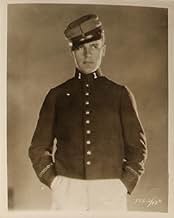Aggiungi una trama nella tua linguaMichael "Beau" Geste leaves England in disgrace and joins the infamous French Foreign Legion. He is reunited with his two brothers in North Africa, where they face greater danger from their ... Leggi tuttoMichael "Beau" Geste leaves England in disgrace and joins the infamous French Foreign Legion. He is reunited with his two brothers in North Africa, where they face greater danger from their own sadistic commander than from the rebellious Arabs.Michael "Beau" Geste leaves England in disgrace and joins the infamous French Foreign Legion. He is reunited with his two brothers in North Africa, where they face greater danger from their own sadistic commander than from the rebellious Arabs.
- Regia
- Sceneggiatura
- Star
- Premi
- 5 vittorie totali
- Prince Ram Singh
- (as Ram Singh)
Recensioni in evidenza
None of the characters have quite enough time to become quite endearing as individuals, but the mysteriousness of the opener makes the film enjoyable to watch. However, audiences are greeted with many familiar and competent actors. Don't worry though; the ending is very satisfying.
I've seen, and enjoyed, the 1939 version starring Gary Cooper, and now I know that that later version closely followed this original. Director and screenwriter Herbert Brenon does a tremendous job with the Legion sections of the film, and it's surprisingly violent. The sections showing the Gestes as kids goes on a bit long, though. The opening segment of the film is revisited later, with the events shown from a different angle. I wonder how often that narrative device had been used by this point, if at all. The cast stand out for me was William Powell as Boldini, a shifty thief and scoundrel (someone calls him a "jibbering jackal" at one point) who is also in the Legion.
Now, I'm not a fan of sweeping epics. I, for one, hate David Lean's work with a passion. But in the silent days, many a great epic film was made, and this in one of them.
Probably the most incredible thing is the sheer size of this movie. The opening scenes of the french troops advancing toward the fort, or later with the arabs doing the same thing, are astounding. Unlike in Lean's work, where crowds of chattering background players rush about in every direction, director Herbert Brennon skillfully weaves his literal army of extras over the sand dunes, obviously going to great lengths to ensure that he gets a breathtaking shot. And cinematographer Roy Hunt captures it impeccably, only as an artist would. I'd like to see more of his.
I saw this movie last night in a restored silent movie theater with live organ accompaniment. The organist, the incredible Dennis James, mentioned that some audience members might feel that they had seen this film before, only that they thought that it was with Gar Cooper. I haven't seen that version, but apparently it's almost a shot-for-shot remake. I'd love to see it if it's even half as good as this one.
Those Legionnaires got paid a wad of dough because -- in real life, anyhow -- they were brutal, mercenary killers employed by an imperialist power to wipe out Arabs and anybody else who got in its way. Not that the Arabs were such nice guys either but, of course, the film presents all this with the complexity of a cowboys-and-Indians B western. Having your hero join the Legion with no qualms is sort of like having your hero join the Ku Klux Klan, except that the Klan wasn't as efficient a group of racist mass-murderers.
Absurdities and implausiblities aside, the film holds its grip pretty well, not because of epic elements like mobs of attacking Arabs, shots of marvelously oppressive desert vistas, etc., but because of the unstressed acting amidst all the mayhem and intrigue. I tend to agree with the critic who wrote that, in the 1939 version, Gary Cooper merely played Gary Cooper but that, in the '26 version, Ronald Colman embodied Beau Geste. Everyone else is fine and if the villain is over-the-top, it's certainly forgivable on this occasion.
There's a lot of bugling in these French Foreign Legion pictures and whoever accompanies this long silent will have to struggle to stay in perfect sync with all the various fanfares, especially a necessary rendition of "Taps" near the climax.
Lo sapevi?
- QuizContrary to reference books on the subject, the film did not have Technicolor inserts according to Technicolor's records. Some Technicolor footage was indeed photographed for the production, but not used in the final print.
- Citazioni
Lady Patricia Brandon: If the sapphire is not returned by morning, I shall be more sorry than I can say - to know that one of you is a common thief!
- Versioni alternativeA VHS version in Argentina seems to have been lifted from a worn, but acceptable, 16mm print. This print features organ music accompaniment and the editors added Spanish language subtitles.
- ConnessioniFeatured in The House That Shadows Built (1931)
I più visti
- How long is Beau Geste?Powered by Alexa
Dettagli
Botteghino
- Lordo Stati Uniti e Canada
- 1.708.926 USD
- Tempo di esecuzione1 ora 41 minuti
- Colore
- Mix di suoni
- Proporzioni
- 1.33 : 1
Contribuisci a questa pagina






































